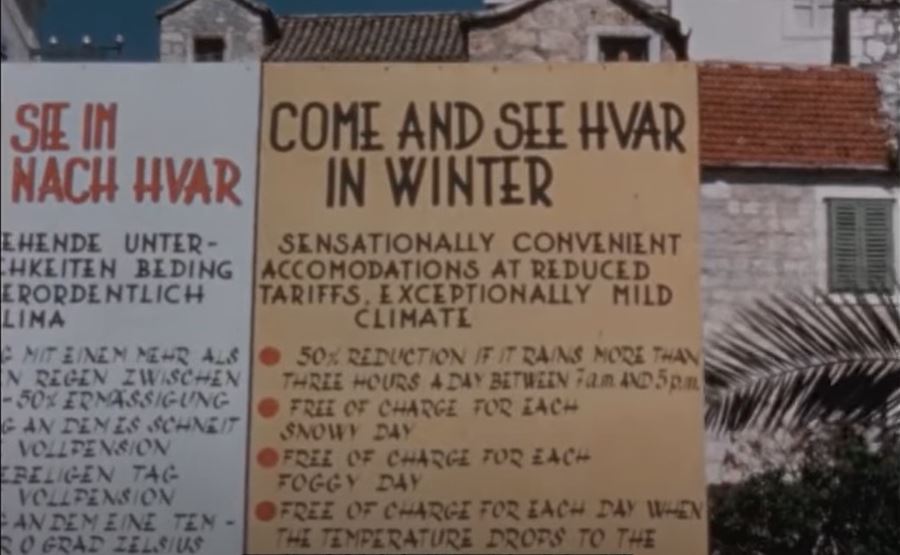Snow on Hvar! And the Truth Behind 'Free Hotel When It Snows' Legend
February 13, 2021 - Snow on Hvar is always a national media event, and so it proves today. But are the hotel stays really for free?
One of the first things I heard when I came to Hvar for the first time was that it had the best climate in Europe. And over the 13 years I lived there full-time, I certainly had no complaints (but then I am a Manchester boy, born in the rain, whose boarding school is in the Guinness Book of Records for most rainy days in one year - 332 days...).
Apparently, the hotels would give you a free hotel room if it snowed, so confident were the hoteliers in the island's unbeatable weather. A great marketing trick, I thought to myself, as snow only falls in winter when there are no tourists.
Of course, the moment I got off the ferry having driven all my stuff to my new home from Oxfordshire, some funny white stuff started falling from the sky around Stari Grad. I have been blamed for any bad weather on Hvar ever since.
But nothing was like February 4, 2012 (see lead photo) when we awoke to find Jelsa covered in a blanket of white. We had business in Hvar Town that day. Driving in 4-wheel drive through the snow on the main road was surreal, but not as surreal as watching a snow plough coming in the opposite direction. On Hvar!
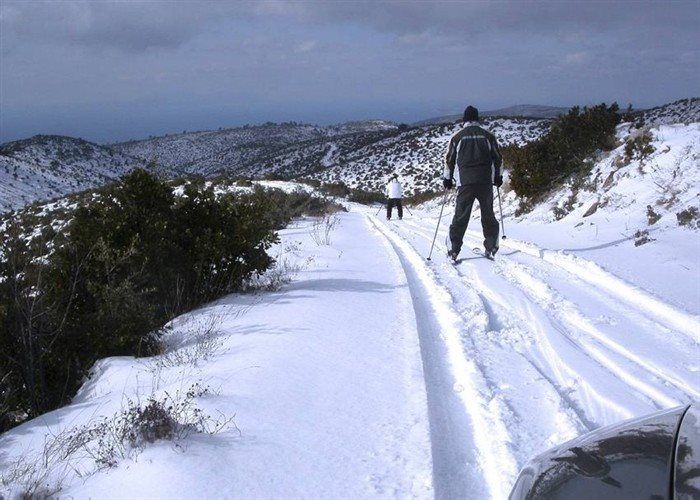
People even skied from the top of Hvar to the beach at Dubovica - read the full story.
I was amazed. How was it possible, with Dalmatian covered in snow and ice, that someone could spare a snow plough to send to Hvar? Upon investigation, it turned out that the sunshine has its very own snow plough, which is operated by the chap who owns the restaurant in Vrbanj. He must have less work than Santa Claus.
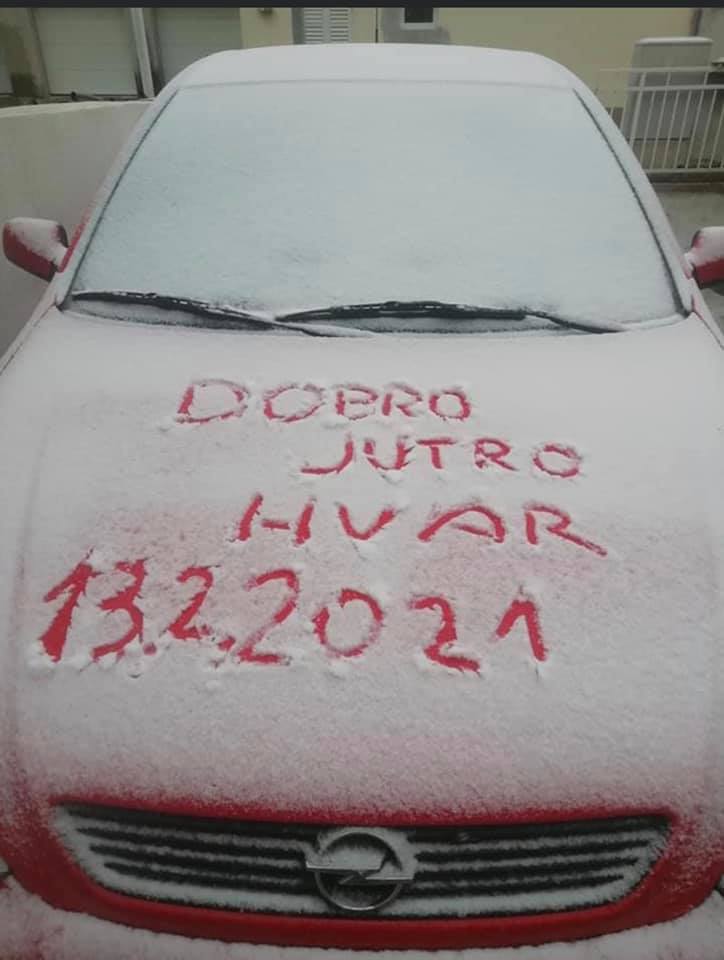
(HVAR Facebook page)
Snow fell once again today, as in much of Dalmatia, a moment which always causes excitement with the local kids, and locals mark the event in their own special ways.
So are the hotels actually free? It was something I decided to chase up back in 2012 and I asked Suncani Hvar Hotels what the official policy was. The reply was that if it had been snowing for 7 days then guests could get the 8th day free.
Not quite the same thing.
Some years later, I chanced upon what appears to be the origins of the claim, in a 1960s video of Dalmatia. Here is what was advertised on Hvar.
(YouTube screenshot)
1. 50% reduction if it rains more than three hours between 7 am and 5 pm
2. Free stay for each snowy day
3. Free stay for each foggy day
And a free stay if the temperature drops below a certain temperature (0 degrees).
I wonder if they are still valid in 2021...

(A sunny day in Varazdin - Photo by Taliah Bradbury)
Meanwhile, the morning started wonderfully in Varazdin this morning. People thought I was crazy to move from the sunshine island to the cold and forbidding north of Croatia.
For more news about the island of Hvar, follow the dedicated TCN Hvar section.
Zagreb Remains Blossoming Croatian IT Industry's Very Centre
February the 13th, 2021 - The Croatian IT industry's heart is located in Zagreb and the growth of this still blossoming sector is well known as it continues to come on leaps and bounds. Although this is in itself somewhat old news, just how advanced is Zagreb when it comes being the home to the Croatian IT industry?
As Novac/Bernard Ivezic writes, the extent to which the Croatian capital is the true heart of the Croatian IT industry has now finally been looked more deeply into as a study was conducted into precisely that. As much as four-fifths of the Croatian IT industry is located in the bustling City of Zagreb according to the latest Croatian Chamber of Commerce's IT study, which will be presented on February the 16th, 2021.
According to the study, which expands over more than 188 pages when compared to the previous such analysis of the Croatian IT industry from 2008 onwards, it is stated that IT companies located in Zagreb back in pre-pandemic in 2019 enjoyed an impressive 21.37 billion kuna in revenue, which is almost 80 percent of total Croatian IT industry revenue.
The Croatian Chamber of Commerce (HGK) and the Croatian IT industry itself has stated that the City of Zagreb is the headquarters of as many as 51 percent of all IT companies operating within the country and that 63 percent of all IT employees work there.
Opposite the City of Zagreb are two counties in which one company represents the entire IT industry there, the frequently overlooked continental areas of Bjelovar-Bilogora and Koprivnica-Krizevci County.
Goran Mrvos, president of the IT Association at the Croatian Chamber of Commerce, says that the aforementioned research was done in cooperation with Boris Zitnik from Omnia Consulting and Dalibor Suboticanc from the Research Factory.
''This year's analysis is supplemented by data on investments in research and development from the years 2008 to 2019 and offers an overview by counties for the total period, and our goal is to provide a good insight into the level of innovation and guidelines for IT industry development by IT company category,'' concluded Mrvos.
For the latest travel info, bookmark our main travel info article, which is updated daily.
Read the Croatian Travel Update in your language - now available in 24 languages.
Join the Total Croatia Travel INFO Viber community.
Laguna Plans to Increase Korcula, Peljesac Hotel Capacities
February the 13th, 2021 - An increase in Korcula and Peljesac hotel capacities is on the cards as Laguna lays out its tourism plans for 2021's summer season, should all be remotely normal in regard to the coronavirus pandemic by the time the warmer summer months roll around.
As Poslovni Dnevnik/Suzana Varosanec writes, with its recently announced offers, the Laguna Novigrad hotel company is set to take over the remaining shares of HTP Orebic and HTP Korcula, and is strengthening the position of the Management Board by appointing a brand new member - Dino Hrelja, who has since taken over said function.
Laguna has stated that Hrelja's appointment is a continuation of the integration of companies into the business system of Aminess' hotels and camps. The priority now, they added, is the best possible preparation of the upcoming (and what is likely to again be very challenging) Croatian tourist season on the island of Korcula and in Orebic on the Peljesac peninsula. Regardless of the global disruptions in tourism, this company believes that both of these areas have significant development potential.
The takeover bids were published in the Official Gazette (Narodne Novine) on the 10th February, 2021, and the bidder Laguna Novigrad, in cooperation with the acquired company Dalmacija hoteli (Dalmatia hotels), through which it became the majority shareholder, has stated that it has four hotels in Novigrad, Orebic and Korcula, as well as two camps in Novigrad, Istria.
Back in pre-pandemic 2019, they realised an impressive 749,944 overnight stays in total, and their net profit stood at an equally impressive 24.24 million kuna.
The company's offer will be positive for both hotel companies, they say, and will not have a negative effect on the rights and status of their employees. The strategic goals include the possibility of using operational, financial and other sectoral synergies, which will result in greater profitability.
They are announcing the raising of the quality of their destination of the Peljesac peninsula, as well as more Peljesac hotel capacities, as well as the same on the nearby island of Korcula through investments in capacity renewal, the overall expansion of their offer, and their share of individual guests through the existing Aminess channel.
For the latest travel info, bookmark our main travel info article, which is updated daily.
Read the Croatian Travel Update in your language - now available in 24 languages.
Minister Josip Aladrovic Talks Government Support as Measures Ease
February the 13th, 2021 - Minister Josip Aladrovic has discussed what business owners can expect in regard to continued financial support from the Croatian Government as the country will slowly begin to ease some measures relating to the current ban on their work as of Monday.
As Poslovni Dnevnik writes, Labour Minister Josip Aladrovic has revealed how the latest easing up of Croatia's anti-epidemic measures will affect the economy and how we're dealing with the consequences of those previous closures.
Josip Aladrovic commented on the easing of measures for HRT, saying that the decision was guided by lower infection figures in the recent period and the expectations they have for the next period.
"We believe that this sort of measure easing is the optimum thing at the moment. In addition to epidemiological measures, we've also enabled the use of economic measures to overcome this crisis as easily as possible. We consider the activities we've reflected on to be the most important to protect businesses at this time,'' said Josip Aladrovic.
"At this moment, it isn't realistic to go for the greater relaxation of any coronavirus measures. New strains of the virus have emerged and we don't know what effects they could leave on the epidemiological picture. This is a signal to citizens and enterprise owners that we've relaxed certain things to make it easier for everyone to fight the pandemic. This is what's currently realistic and what we believe is opportune at the moment from both the economic and epidemiological point of view,'' he added.
Aladrovic also confirmed that business owners who open their doors on Monday can continue to count on government grants.
"Measures to preserve jobs are in force until the end of February for those who plan to open their businesses on Monday and for those who aren't or can't. The reimbursement of fixed costs will continue being done using the the same principle. We want those who work in catering and hospitality and all those who had to closed to realise at least one part of their income through this relaxation of these measures, and the other part of it, as it was before, will be borne by the state,'' he said.
Aladrovic noted that the measures which were last adopted were due to continue until the end of February, and in the coming days he'll consider options related to the epidemiological framework and economic measures.
"We all need to be aware of our fiscal constraints and what the impact of these measures is on the state budget," he said, warning that there would be some tightening of economic measures, too.
"To all those whose business is objectively endangered, the state will be on their side as it was before," he said, before going on to confirm that the problem of delays in the payment of aid for the preservation of jobs has now thankfully been resolved.
"For the month of January, 19,000 out of 29,000 requests were processed, and 250 million kuna has been paid out to those businesses so far. Within ten to twelve days, everything else will certainly be paid out," he said.
Unemployment is visible on the Croatian labour market, and Josip Aladrovic pointed out that the pandemic had certainly left its mark, but added that Croatia recorded a drop in employment of only 7,000 insured persons when comparing the end of January this year with the end of January 2020, just before the pandemic began to truly take hold on a global scale.
"These are positive trends, that's what makes us happy. There are certain sectors that have experienced significant growth like the IT and construction sectors,'' he said.
Speaking about the European Commission's latest GDP forecasts, Aladrovic said that the growth rates are slightly higher than the ones forecasted by the government, while the fall rates for last year are lower than expected.
"In the past three weeks, we've seen a significant increase in demand for labour. This means that all those who are preparing for the tourist season and builders who are oriented to those areas affected by the earthquakes are significantly preparing for a wave of employment. We expect that all this will have positive economic consequences,'' he said.
For the latest travel info, bookmark our main travel info article, which is updated daily.
Read the Croatian Travel Update in your language - now available in 24 languages.
Learning Croatian: Articles of Clothing in Hvar Dialect (VIDEO)
February 13, 2021 - Continuing our look at the Croatian language through Hvar dialect, some important things to know about articles of clothing, with a cameo appearance from a famous winemaker.
Learning Croatian on a Dalmatian island is not recommended, unless you find a teacher who can teach you classic Croatian rather than the local dialect. It was a lesson I learned at great cost when I went to Zagreb some time later, only to find out that my shiny new Croatian words were actually unintelligible to most people who were not from Hvar.
Add to that the famous Dalmatian Grunt, perfected by the one and only Frank John Dubokovich, and the concept of a video series on Hvar dialect was born. As previously mentioned, the original YouTube series dating back to 2011 was taken down for some reason, but some of it has survived on an old camera.
Today's lesson is probably my favourite, focusing on articles of clothing in Hvar dialect. Over the years, the lessons achieved something of a cult status on Jelsa's main square, and various people were quick to add their expertise, sometimes even to contradict the great Professor Frank John Dubokovich, Guardian of the Hvar Dialects.
The other problem, which was probably linked to the number of cold ones consumed prior to recording, was that filming (always one take only) often coincided with the ringing of the midday church bells. This week's episode descended into chaos, with a combination of those bells, as well as the linguistic intervention of the Three Wise Men, including legendary Jelsa winemaker, Andro Tomic.
You can subscribe to the TCN Talks YouTube channel for the latest language instructions from The Professor.
For the latest news from the island of Hvar, check out the dedicated TCN Hvar section.
Looking to improve your Croatian as a foreigner? 25 Mistakes Foreigners Make When Speaking Croatian.
Two Croatian Destinations on Forbes' Most Romantic Destination List
February the 13th, 2021 - Two Croatian destinations have made it onto the latest of Forbes' prestigious lists as Valentine's Day quickly approaches. The pandemic might be raging on and travel may be difficult, but we're sure many people outside of Croatia will be daydreaming about the romantic Croatian coast.
As Novac/Jozo Vrdoljak writes, as Valentine's Day 2021 approaches, the highly influential American magazine Forbes published a list of sixteen of the most romantic destinations in Europe, including two Croatian destinations, Opatija and the islet of Galesnjak, said Ina Rodin, the director of the the Croatian National Tourist Board (HTZ) across the Atlantic in the United States of America.
Of these two Croatian destinations, beautiful Opatija, known as the old lady of Croatian tourism, is presented as a fashionable coastal resort and a jewel of the Kvarner area in the Northern Adriatic, whose tourist traditions date back to the 19th century.
The unique Opatija villas and hotels are surrounded by exotic gardens, parks and the stunning Croatian Adriatic sea, as well as the city's famous chocolate production. Then you have a tour of the islet of Galesnjak at hand, the possibility of discovering this beautiful little heart-shaped island by boat or plane with a panoramic view of the ancient Dalmatian city of Zadar and the Kornati archipelago.
Just the descriptions of these two Croatian destinations alone will surely be enough to set of a sense of longing in the hearts of anyone wishing for a romantic getaway in these difficult and unprecedented times in which just hopping on a plane with ease seems truly alien.
Croatia aside, this Forbes selection is, as stated, a compilation of some of the most romantic destinations for Valentine's Day in Europe, compiled by the European Best Destination Organisation.
Along with Opatija and Galesnjak, the list includes the Portuguese island of Porto Santo, Spicnik in Slovenia, Italian Burano, Dinard in Brittany, Oia in Santorini, Greece, Mijas in Andalusia, stunning Polperro in Cornwall, England, Lake Como in Italy, the Algarve in Portugal, Sveti Stefan in neighbouring Montenegro, Gdansk and Sopot in Poland, Rossa in Switzerland, Rothenburg Ob der Tauber in Germany, and Preveli on the Greek island of Crete.
For the latest travel info, bookmark our main travel info article, which is updated daily.
Read the Croatian Travel Update in your language - now available in 24 languages.
Hvar Covered in Snow This Morning Again After Three Years
February 13, 2021 – Have you ever imagined the Croatian island of Hvar covered in snow? It sounds unbelievable for one of the sunniest islands in the Mediterranean, but today it snowed again in Hvar, just like three years ago.
The announced cold front arrived in Croatia, and even in its warmest parts. Even the Croatian island of Hvar was covered in snow this morning.
Three years ago, one of the sunniest islands in the Mediterranean was covered by snow for the first time in 25 years. This morning, the Hvar town people woke up just like in 2018 – seeing their city covered with a thin white blanket.
"It's always nice to see a little bit of winter joy because we don't see it often. We are not used to this, but let it last for a few days. We will endure the cold," said Vedran Dulčić, Hvar native, who sent us a photo from the town of Hvar.
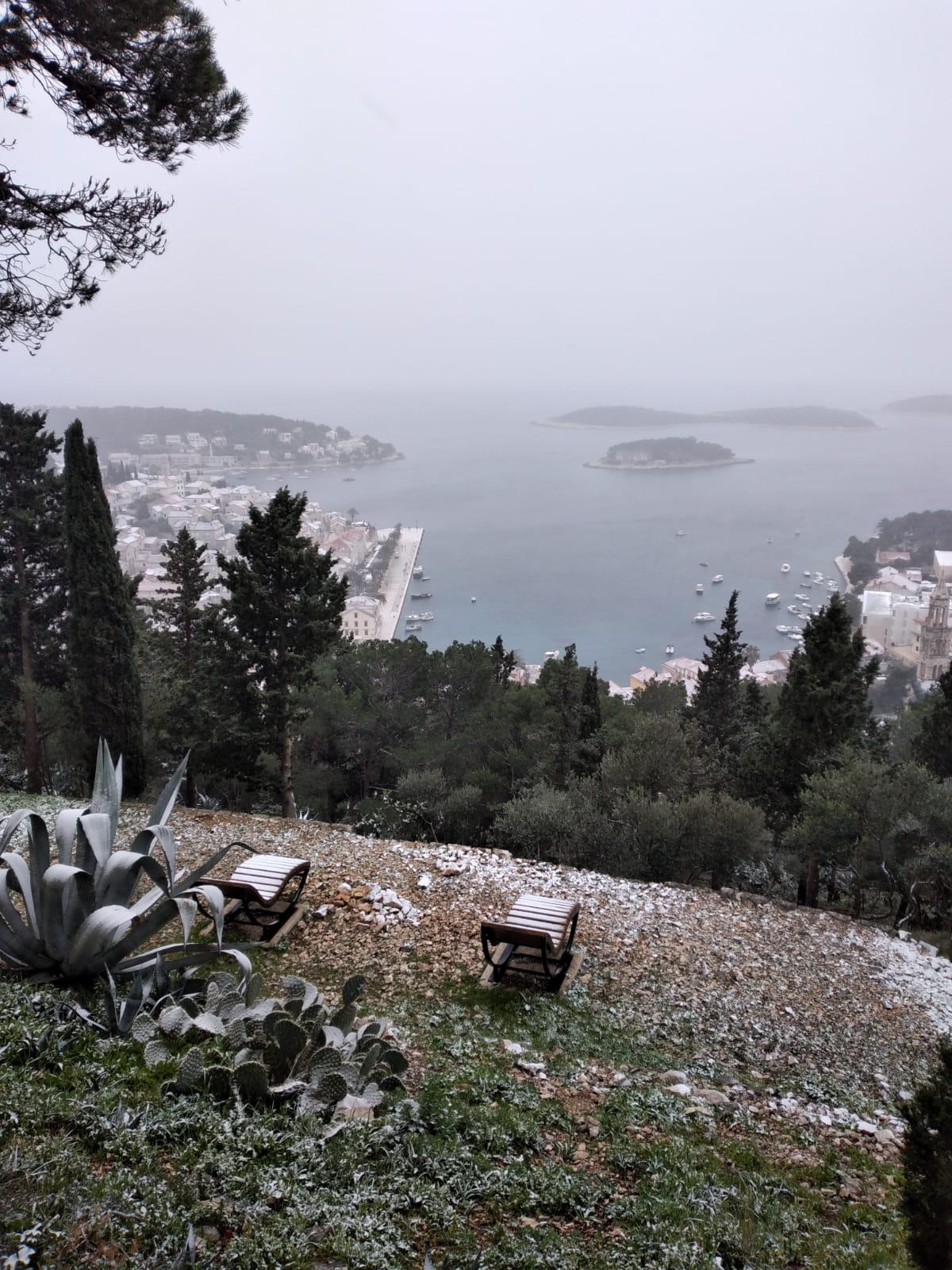
A view from Hvar Fortress (Fortica), an unavoidable place in Hvar, looks like this today. The Hvar port, perfect blue sea, and Pakleni islands in the background, which a beautiful view overlooks during the summer, are now barely even seen.

Facebook Hvar Town
It's also very cold. Hvar residents say that the stormy wind bura started to blow, and they predict (or at least hope) that the snow will not last long. By midday, it already almost melted. However, in 2018, the snow on Hvar stayed for more than a week.
For people who are used to temperatures above 30 degrees Celsius on Hvar, today's only one degree is not pleasant at all, but they try to endure it. Just a few more months and there will be summer, right? Although it is beautiful even in winter conditions, nothing can compare to the beauty that Hvar exudes in summer.
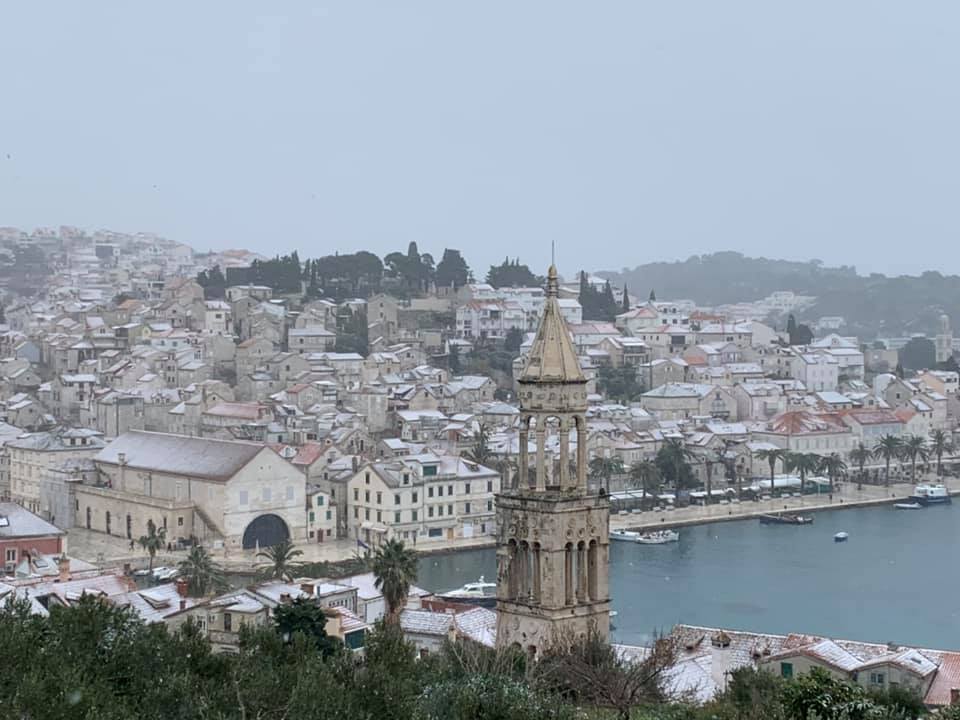
Facebook Secret Hvar travel agency
For the latest travel info, bookmark our main travel info article, which is updated daily.
Read the Croatian Travel Update in your language - now available in 24 languages.
Senate to Discuss Situation at Zagreb University in One Month
ZAGREB, 13 February, 2021 - The chairman of the University of Zagreb University Council, Luka Burilović, said on Friday the Council requested and rector Damir Boras accepted to convene a Senate session on the state of affairs at the university in a month's time.
Speaking to the press, Burilović said Boras attended the session as a guest.
Asked if the University Council discussed the rector's responsibility for the situation at the university, he said the rector answered to the Senate and that only the Senate could discuss the rector's responsibility and make a decision. The University Council, he added, is an advisory and oversight body.
Constituent units should deal with sexual harassment
The Council also discussed the reports of sexual harassment at the university, concluding that the university must be a place of zero tolerance to any abuse and made it clear that sexual harassment and abuse is humanly, ethically and morally unacceptable.
The Council also expressed regret and strong support to all victims, referring them to take institutional action in line with the university's Code of Ethics.
Speaking of the Code, Burilović said it was from 2007 and that the Council recommended that the governing structures establish a permanent expert body that would oversee and help the university's constituent units deal with sexual harassment reports.
The Council also recommended organising comprehensive education for employees and students to prevent sexual harassment and abuse as much as possible.
Two Moderate Aftershocks Jolt Petrinja Area
ZAGREB, 13 February, 2021 - Two moderate earthquakes measuring 3.7 and 3.3 on the Richter scale were recorded on Saturday morning with the epicentre near Petrinja, Croatia's Seismological Survey said.
The magnitude 3.7 tremor occurred at 4.55 am and the magnitude 3.3 tremor at 5.19 am.
The quakes were felt in Zagreb as well.
The Petrinja area was hit by a magnitude 6.2 earthquake on 29 December which killed seven people and caused enormous damage.
Slatina Sparkling Wine Find Makes Slavonia Champagne Among Croatia's Oldest
February 13, 2021 – A newly discovered, fully preserved bottle of 'Slavonia champagne' is unique evidence that Slatina sparkling wine is among the oldest in Croatia. Its fascinating history stretches back over 150 years
A completely preserved Slatina sparkling wine bottle from the period from 1864 to 1912 has been discovered during building works of Slatina's new visitor's centre. Found at a depth of two metres, the bottle is physical proof of what was previously known only from records – this 'Slavonia champagne' is among the oldest sparkling wine to have been made in Croatia. © Robert Turkalj
© Robert Turkalj
The discovery of the Slatina sparkling wine bottle is important to the city and its history. Other regions in Croatia have become extremely well regarded over recent years for their production of quality sparkling wines. The production of Slatina sparkling wine briefly disappeared during a period. But, this bottle is evidence that Slatina sparkling wine was among the first to be made in the country. It is the only fully preserved bottle of the 'Slavonia champagne' to exist in the region.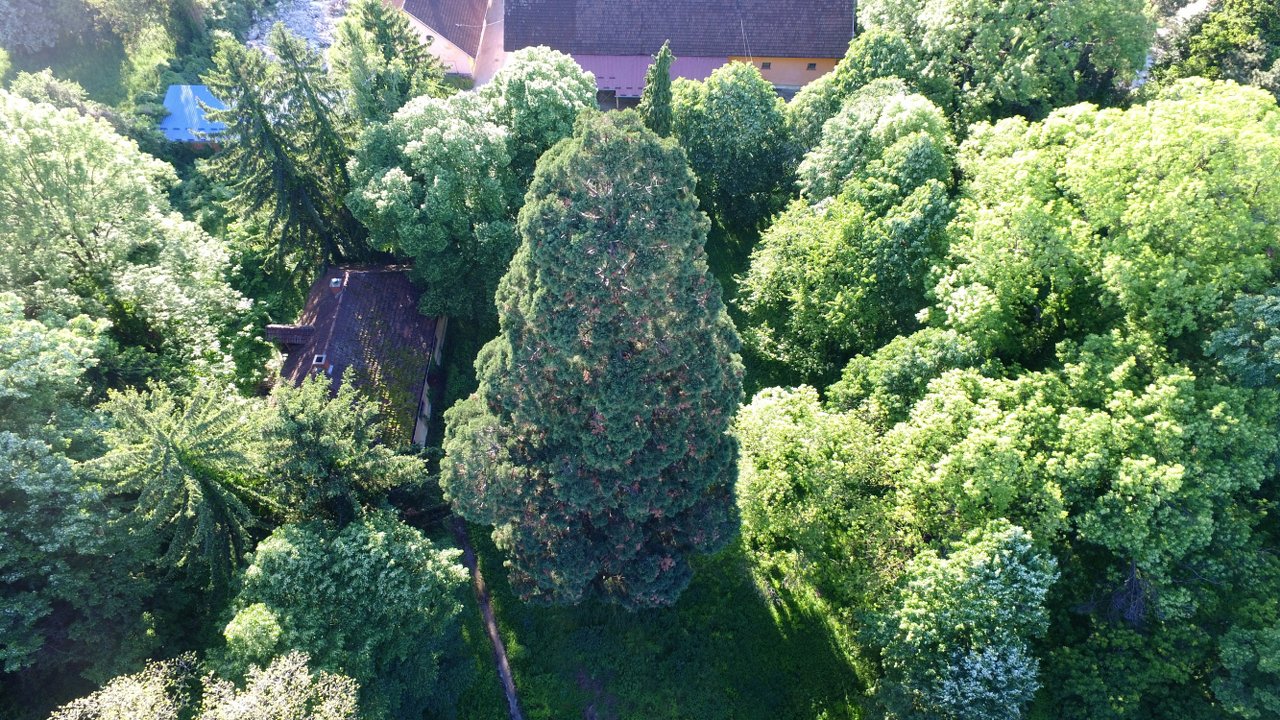 Slatina's nationally protected Giant Sequoia tree (Mamutovac) © Tourist Board of Slatina
Slatina's nationally protected Giant Sequoia tree (Mamutovac) © Tourist Board of Slatina
Of course, we can't really call it champagne – that title is reserved for a type of sparkling wine made in a distinct geographical region in France. But, there are great similarities between Slatina sparkling wine and champagne - similarities that do not exist exactly in other Croatian sparkling wines. Champagne is largely made from the Pinot Noir grape. The found bottle of Slatina sparkling wine was made from the Kadarka grape variety, which has been compared to Pinot Noir.
Both grape varieties are thin-skinned, delicate, easily susceptible to impairment and require a low yield to produce quality wines. Both are tricky to cultivate. For this reason, the Kadarka grape variety is now grown very rarely in Croatia, its place in vineyards taken by more hardy and some imported varietals. But, that wasn't always the case.
History of Slatina sparkling wine
In 1841, the German prince Georg Wilhelm Schaumburg-Lippe bought a property of land in the Slatina area from the Pejačević family. The land contained vineyards, orchards, agricultural fields and large forest areas, including the site of the new Slatina visitor centre where the bottle was discovered. Indeed, trees still line the road of Ulica kralj Zvonimir in the centre of Slatina – the cellar and restaurant of the town's famous Stari Podrum is just a few metres from Slatina's nationally protected Giant Sequoia tree (Mamutovac).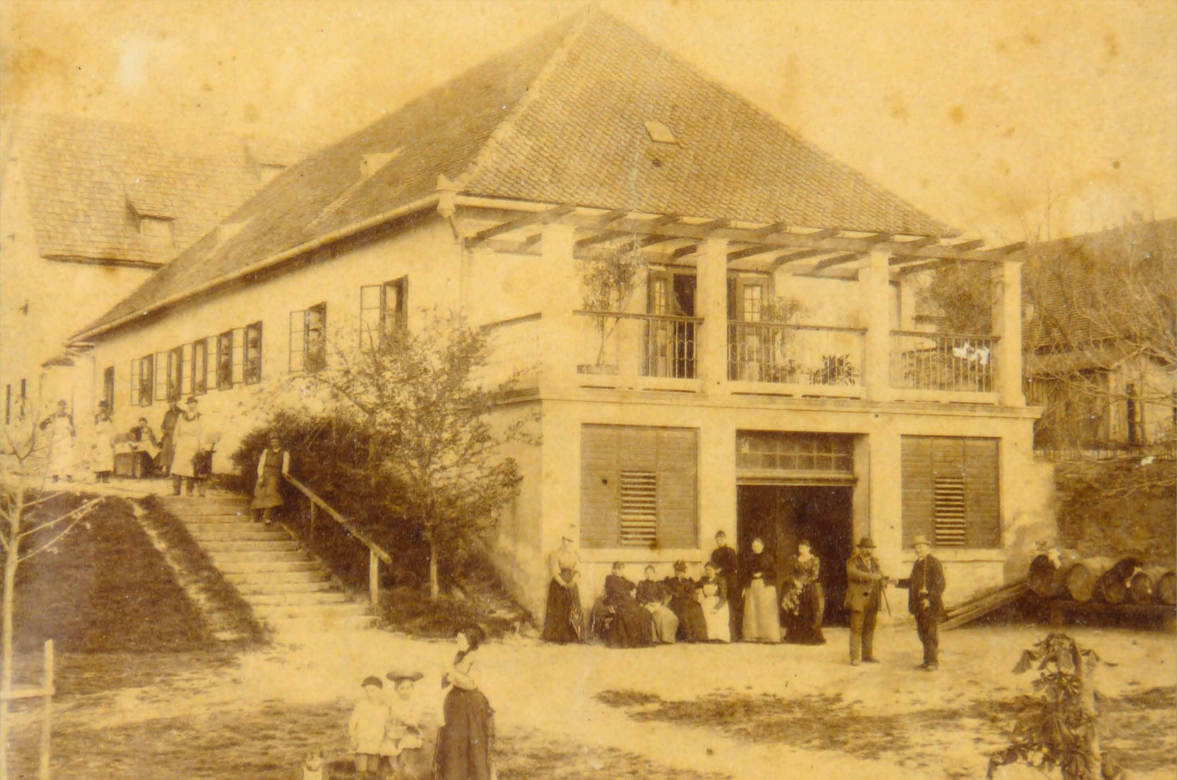 The Stari Podrum cellar, the site of the first-ever production of Croatian sparkling wine, at the beginning of the 20th century © Virovitica State Archives / Slatina Homeland Museum
The Stari Podrum cellar, the site of the first-ever production of Croatian sparkling wine, at the beginning of the 20th century © Virovitica State Archives / Slatina Homeland Museum
Slatina sparkling wine production started in 1864 at the Stari Podrum cellar, using the Kadarka grape variety. Perhaps it was the notorious difficulties of the growing the grape which resulted in slow initial progress for the production, but the enterprise got a massive boost in 1866 with the arrival of a new manager, Otto Rockhror. He rearranged the cellar and production, brought in new equipment and invested in marketing their Slatina sparkling wine. It worked.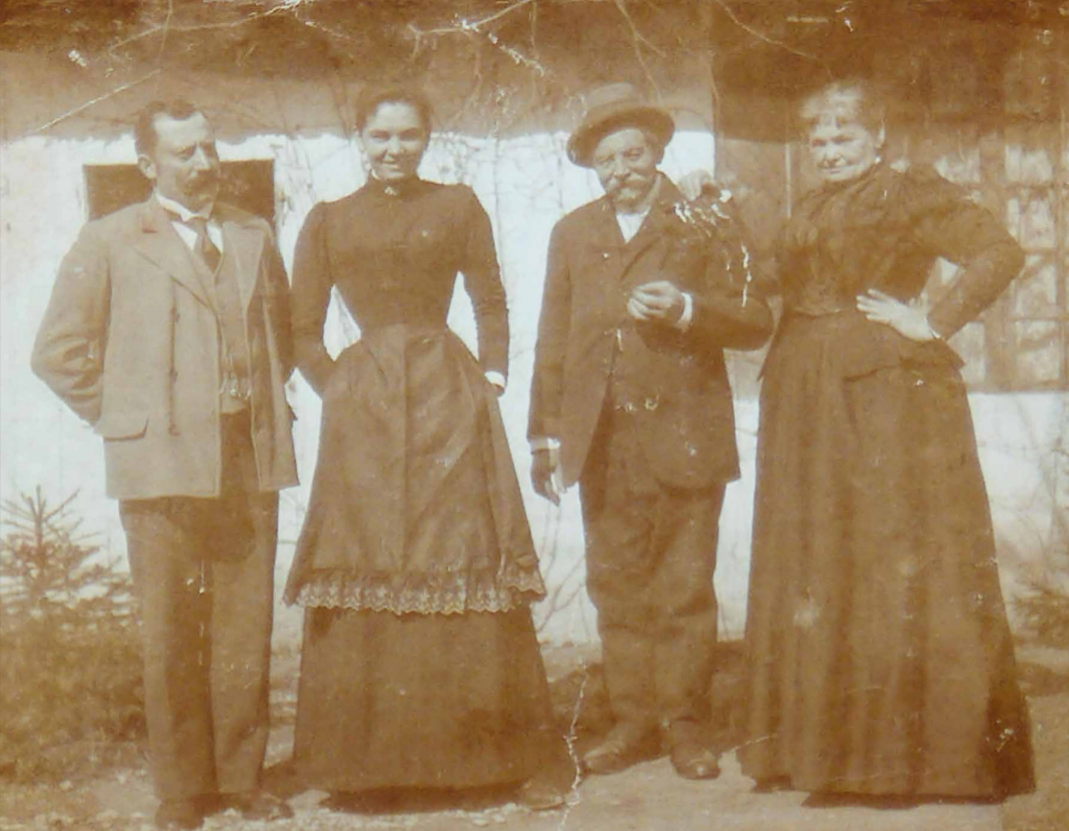 Left to right - Ljudevit Konstantinović, his wife Marija Konstantinović (the daughter of Otto Rockrohr), Otto Rockrohr and his wife Josefina Rockrohr © Virovitica State Archives / Slatina Homeland Museum
Left to right - Ljudevit Konstantinović, his wife Marija Konstantinović (the daughter of Otto Rockrohr), Otto Rockrohr and his wife Josefina Rockrohr © Virovitica State Archives / Slatina Homeland Museum
The quality of Slatina sparkling wine was recognized at the great Economic and Forestry Jubilee Exhibition in Zagreb in 1881 when Georg Wilhelm Schaumburg-Lippe received an honorary diploma and a large medal for domestic sparkling wine and fine wine. The credit perhaps lay elsewhere, considering it was the efforts of Otto Rockhror that were no doubt the cause, but, such were the times. However, Otto Rockhror's achievements with Slatina sparkling wine certainly did not go unnoticed.
At the Science and Industry Fair in Brussels, Belgium, in 1888, Otto Rockhror was awarded a bronze medal featuring the image of Leopold I. He received a further bronze medal with the image of Francis Joseph I in 1890 at the Agricultural and Forestry Exhibition in Vienna and was awarded a silver medal with the image of Franz Ferdinand in 1894 in Vienna by the Association for the Promotion of Agricultural Knowledge. These medals are on display in the Slatina Homeland Museum, donated by Otto Rockhror's great-granddaughter Jasna Nosso. They sit alongside a wooden barrel used in the production of Slatina sparkling wine from 1885 and, now, the latest testament to the history of Croatia's oldest sparkling wine production, the newly discovered bottle, which has been transferred to the museum for preservation, safekeeping and dating. On the left, the bronze medal won by Otto Rockhror at the Science and Industry Fair in Brussels, Belgium, in 1888. On the right, the silver medal with the image of Franz Ferdinand he was awarded in 1894 in Vienna © Virovitica State Archives / Slatina Homeland Museum
On the left, the bronze medal won by Otto Rockhror at the Science and Industry Fair in Brussels, Belgium, in 1888. On the right, the silver medal with the image of Franz Ferdinand he was awarded in 1894 in Vienna © Virovitica State Archives / Slatina Homeland Museum
The production of Slatina sparkling wine from the Kadarka grape did not survive the loss of Stari Podrum cellar manager Otto Rockhror, who died in 1909. Thereafter, ownership of the enterprise was taken over by Count Drašković but, by 1912, production of Slatina sparkling wine had ceased completely and all the production equipment was moved to Hungary. Though the growing of the Kadarka grape variety almost completely died out in Croatia after this, it remains an important part of wine production in Hungary, Bulgaria, Romania and Serbia, where it is grown in Vojvodina, a landscape near-identical to that of Slavonia (indeed, though the heritage of the Kadarka grape is mysterious, the latest opinion is that it is a cross between the Turkish variety Papazkarasi and the Serbian variety Skadarsko and travelled to Pannonia with Serbs who fled north from the Ottomans).
However, the story of Slatina sparkling wine has not only been revived with the discovery of this old bottle. The Stari Podrum cellar still stands in the centre of Slatina today and vineyards still surround the town. The cellar and its wine production were bought by winemaker Ivan Halas over recent years and he has returned the production of Slatina sparkling wine to the historic birthplace of 'Slavonia champagne'. He has since received several awards for his efforts.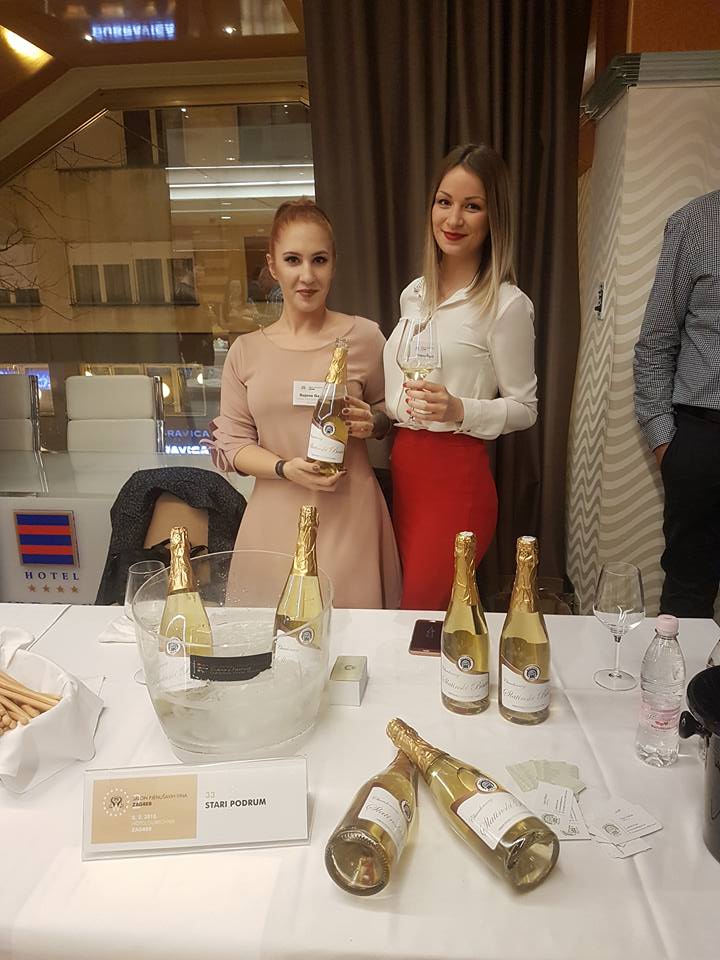 Slatina sparkling wine, revived by Ivan Halas at Stari Podrum, being presented at the 2nd Sparkling Wine Salon at the Hotel Dubrovnik in Zagreb © Tourist Board of Slatina
Slatina sparkling wine, revived by Ivan Halas at Stari Podrum, being presented at the 2nd Sparkling Wine Salon at the Hotel Dubrovnik in Zagreb © Tourist Board of Slatina
“As the Stari Podrum winery does not have adequate conditions for storing the found bottle, we took it to the Homeland Museum in Slatina where it will be stored,” Mr Halas told local news, upon the discovery of the bottle. “Only one bottle was found (so far), although there may be more. It is currently the only fully preserved one in the Slatina area. For now, we assume that it is from the period between 1864 and 1912 - we have no knowledge of the exact year, but the age of the bottle will be determined by experts.”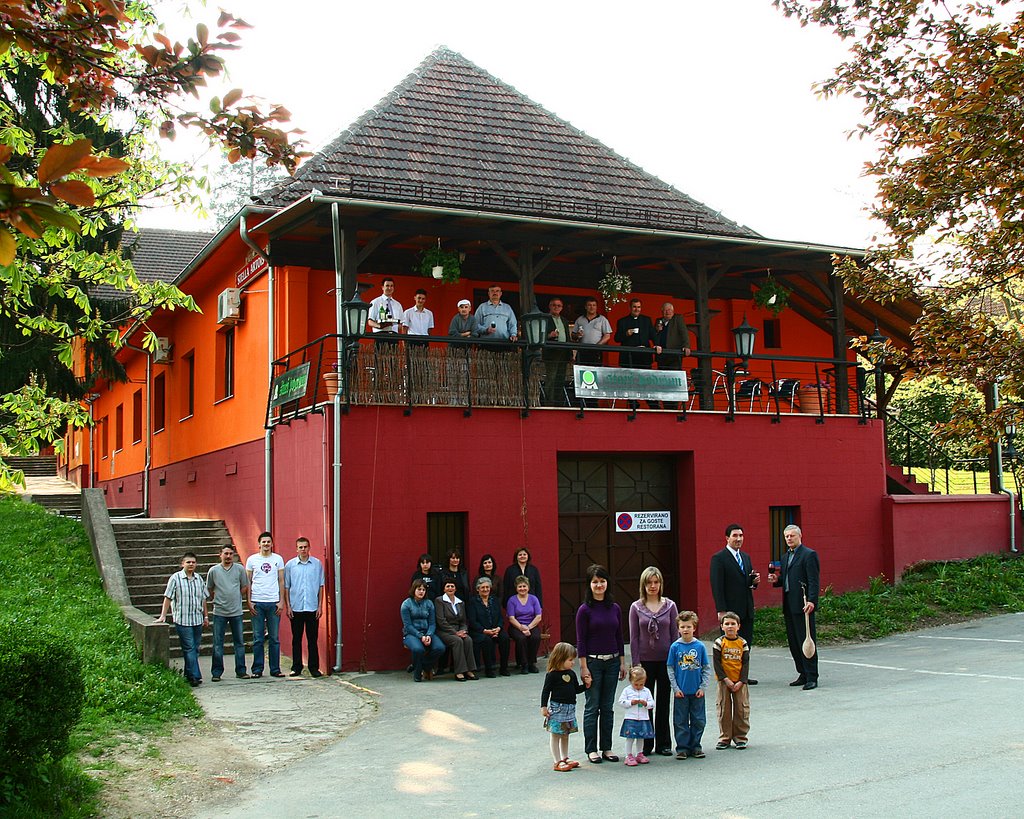 A more contemporary photo of the Stari Podrum enterprise in Slatina © Virovitica State Archives / Slatina Homeland Museum
A more contemporary photo of the Stari Podrum enterprise in Slatina © Virovitica State Archives / Slatina Homeland Museum


